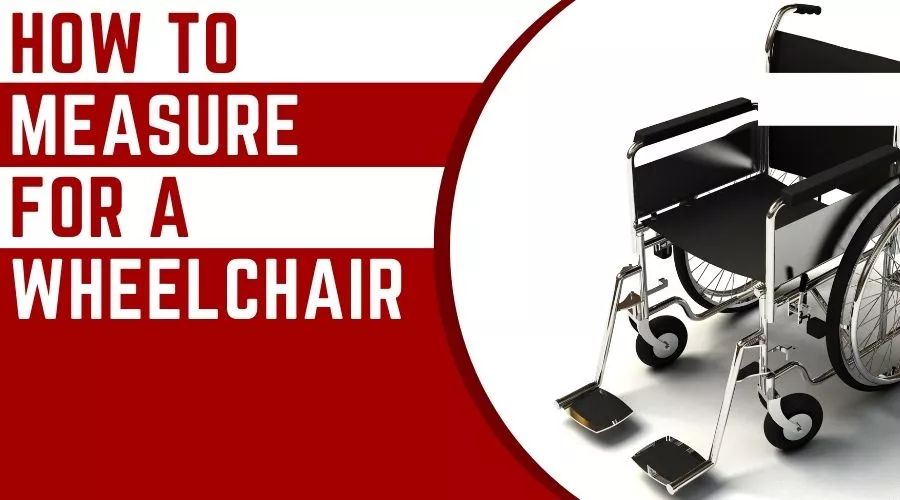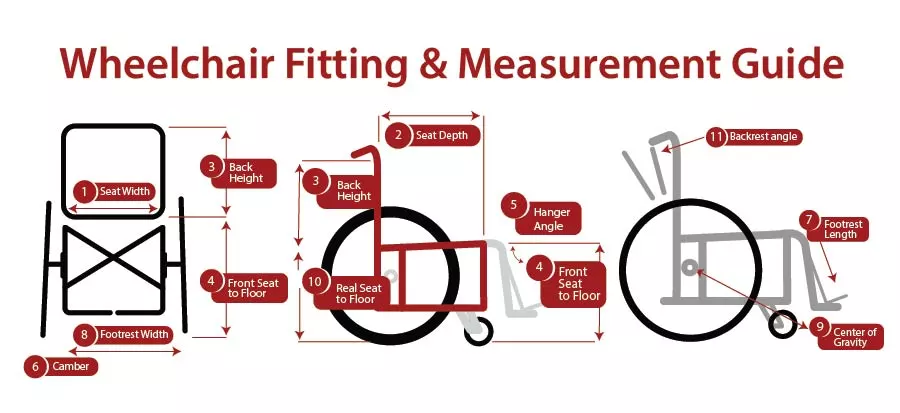
Unleash comfort and freedom with a precisely sized wheelchair! It’s a crucial step to ensure a cozy, stable ride.
Regardless of being a seasoned manual wheelchair user or exploring transport options, This guide has got you sorted.
Dive into the nitty-gritty details of what measurements and factors matter while picking a wheelchair.
Wheelchairs are designed to provide a comfortable and practical mobility solution for individuals who need a wheelchair for their daily activities.
Say goodbye to mediocre seating experiences and join the quest for your tailored fit now!
They are easy to maneuver and transport, making them an ideal option for those who are frequently on the go.

The seat-to-floor height is a crucial factor to consider when determining the correct size for a wheelchair, especially if the user will be propelling the chair with their feet. This measurement, along with seat width, depth, and back height, is essential for configuring a custom or rehab wheelchair accurately. The standard seat-to-floor height for a wheelchair falls between 18 to 20 inches, while the Hemi-Height is between 17.5 to 18.5 inches and may vary slightly among manufacturers. If a lower seat-to-floor height is desired, a “super” or “ultra” Hemi option may be available, which involves changing the rear wheels from a standard 24-inch to 22 or 20-inch, and the front casters from 8-inch to 6 or 5-inch. It’s important to keep in mind that if a cushion is added to the wheelchair, it will increase the seat height by approximately 2 inches.
Importance of Proper Sizing:
Proper sizing is crucial for a comfortable and safe experience while using a wheelchair.
If the wheelchair is too small, the user may experience discomfort, and if it’s too large, it may be challenging to maneuver and control.
The right size wheelchair will allow the user to maintain proper posture, provide adequate support, and promote independence. Inaccurate sizing may also lead to health problems such as back pain, pressure sores, and even injury.
Factors to Consider When Sizing a Wheelchair:
User’s Height and Weight:
The user’s height and weight are critical factors in determining the right size of the lightweight wheelchair.

The seat height should be such that the user’s feet can touch the ground when sitting in the wheelchair, and the seat should be wide enough to accommodate the user’s hips comfortably.
A properly sized wheelchair should also be able to support the user’s weight.
Type of Wheelchair:
Different types of wheelchairs have different specifications, and it’s essential to choose the right type that suits the user’s needs.

For instance, manual wheelchairs are ideal for those who are able to propel themselves, while powered wheelchairs are better suited for those who require assistance in mobility.
User’s Physical Abilities:
The user’s physical abilities play a significant role in determining the right size for the wheelchair.

The user’s posture, flexibility, and strength should all be taken into consideration when choosing the right size. For instance, a user who has difficulty reaching their feet may require a higher footrest.
User’s Daily Activities:
The user’s daily activities also play a crucial role in determining the right size for the wheelchair.

For instance, a user who frequently travels on uneven terrain may require a larger and more robust wheelchair, while a user who mainly uses their wheelchair indoors may be comfortable with a smaller and lighter option.
User’s Comfort Requirements:

Comfort is critical when it comes to choosing the right size of a wheelchair. The user’s individual comfort preferences should be taken into consideration, such as the type of seat cushion, backrest, and armrest.
User’s Health Conditions:

The user’s health conditions should also be taken into consideration when choosing the right size of a lightweight wheelchair. For instance, a user who has back problems may require a wheelchair with a higher backrest for proper support.
How to measure for correct wheelchair size?

Seat Width:
To determine the necessary seat width, sit in a chair and measure straight across the backside, from hip to hip at the widest points. It’s recommended to add 2 fingertips of extra space on each side for comfort.
Seat Depth:
While seated, measure from the backside to the point 2 inches before the back of the knee bend, following the length of the thigh.
Back Height:
Measure from the top of the seat to where the top of the backrest should be. A typical height is 16 inches, but adjust as desired to the nearest whole inch.
Front Seat to Floor:
Measure from the back of the knee to the sole of the foot, subtracting the compressed cushion thickness and adding a minimum of 2 inches for footrest clearance (unless the wheelchair will be foot-propelled).
Hanger Angle:
This measurement determines the angle at which the toes extend from the body, with a tighter angle allowing for easier turning in limited space. The angle is determined by the ability of the knee to bend.
Camber:
This refers to the angle of the wheel in relation to the vertical. More camber provides improved stability and agility but also limits the ability to navigate tight spaces. A typical daily wheelchair has a 3-degree camber.
Footrest Length:
Measure from the edge of the seat to the top rear of the footrest.
Footrest Width:
Measure the distance between the inside of each leg rest tubing.
Center of Gravity:
Measure from the front of the seat back post to the center of the rear axle.
Rear Seat to Floor:
Measure from the ground to the rear seat edge, which determines the slope or “dump” of the wheelchair seat.
Backrest Angle:
Measure the angle of the back post to the floor, with 90 degrees being perpendicular. To estimate the angle from the back post to the seat, subtract 2 degrees for every .5 inch of dump.
How to Choose the Right Size Wheelchair:
A. Assessing the User’s Needs:
The first step in choosing the right size of a lightweight wheelchair is to assess the user’s needs and requirements. The user’s height and weight, physical abilities, daily activities, comfort requirements, and health conditions should all be taken into consideration.
B. Consulting with a Healthcare Professional:
Consulting with a healthcare professional, such as a physical therapist or an occupational therapist, is recommended when choosing the right size of wheelchair. They can provide expert advice on the user’s specific needs and help choose the right size and style of a wheelchair.
C. Trying Out Different Wheelchair Sizes:
Trying out different wheelchair sizes is crucial in finding the right fit. The user should try out different models and sizes to get a feel for what works best for their individual needs.
D. Making Adjustments:
Finally, once the user has found a suitable size, making any necessary adjustments, such as adjusting the armrests or footrests, can ensure maximum comfort and safety while using the wheelchair.
Conclusion:
A. Summary of Key Points:
In conclusion, choosing the right size of a lightweight wheelchair is critical in ensuring the user’s comfort, safety, and mobility.
The user’s height and weight, physical abilities, daily activities, comfort requirements, and health conditions should all be taken into consideration, along with consulting with a healthcare professional and trying out different sizes.
B. Final Thoughts on Wheelchair Sizing:
Selecting the right size for a wheelchair can be a challenging task, but it is essential to ensure that the user has the best possible experience.
Taking the time to assess the user’s needs and make necessary adjustments can ensure maximum comfort and safety while using the wheelchair.
C. Encouragement to Seek Professional Help:
Finally, it is highly encouraged to seek professional help when choosing the right size of a lightweight wheelchair.
A healthcare professional can provide expert advice and help ensure that the user has the best possible experience while using their wheelchair.
FAQS
What is the correct seat width for a lightweight wheelchair?
The correct seat width for a lightweight wheelchair is determined by the user’s measurements and comfort level. It is recommended to measure the hip width and add a few inches for a proper fit.
Can I choose a different model of a wheelchair if the seat width is not suitable for me?
Yes, you can choose a different model of a wheelchair if the seat width is not suitable for you. There are various models available with different seat widths to accommodate the user’s needs.
Does only the seat width determine the size of a wheelchair?
No, only the seat width is not the determining factor of the size of a wheelchair. The overall width, frame length, height, and front frame angle also play a significant role in determining the right size of a wheelchair.
How do I measure the overall width of a wheelchair?
The overall width of a wheelchair is measured from the widest point of the seat frame to the outside of the wheel.
Is the size of a wheelchair different from that of a standard wheelchair?
Yes, the size of a wheelchair is usually smaller than that of a standard wheelchair, making it more suitable for transportation and easier to maneuver.
How do I measure the height of a seated position in a wheelchair?
The height of a seated position in a wheelchair can be measured from the ground to the top of the seat cushion or back height.
Can a reclining wheelchair accommodate a taller user?
It depends on the model of the reclining wheelchair and the user’s measurements. It is important to check the height measure and determine the desired height before choosing a reclining wheelchair.
How do I measure the floor height of a manual wheelchair?
The floor height of a manual wheelchair can be measured from the ground to the floor of the wheelchair.
How do I choose the right size of a manual wheelchair for a user?
To choose the right size of a manual wheelchair for a user, it is important to measure the user’s hip width, overall height, and hemi height. This will ensure a proper fit and comfort for the user.
what is the width of an average wheelchair?
The width of an average manual wheelchair is about 22 inches. However, it is important to note that the width of a wheelchair can vary depending on the specific model and design, and can range from 20 to 30 inches or more. It’s recommended to measure the width of the doorway or space where the wheelchair will be used, and compare it to the specifications of the specific wheelchair model to ensure a good fit.
what is the size of a standard wheelchair?
The size of a standard manual wheelchair varies depending on several factors such as the user’s height, weight, and mobility needs. However, on average, a standard manual wheelchair has the following dimensions:
Seat width: 16-20 inches
Seat depth: 16-20 inches
Seat height (from floor to seat): 19-21 inches
Backrest height: 16-19 inches
Overall height (from floor to highest point on backrest): 36-39 inches
Overall width (when open): 22-25 inches
Overall length (when open): 42-45 inches
It’s important to note that these are general guidelines and the exact dimensions can vary from one model to another. It’s recommended to measure the user and the intended usage space to determine the best size for a specific individual.
What size wheelchair do I need?
To determine the size of the wheelchair you need, consider your height, weight, and mobility needs. Seat width should be comfortable, seat depth should allow you to sit comfortably, seat height should allow for easy transfer and reaching, the backrest should provide proper support, and armrest height should allow for comfort and ease of use. It’s recommended to consult a healthcare professional or a specialist in mobility equipment to help you find the best fit.




